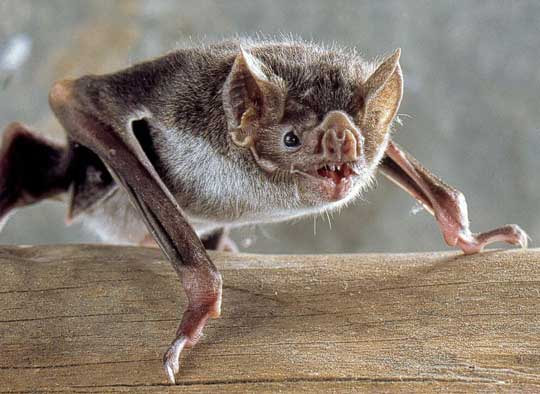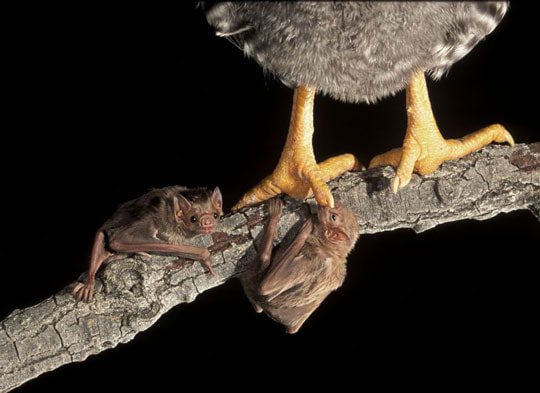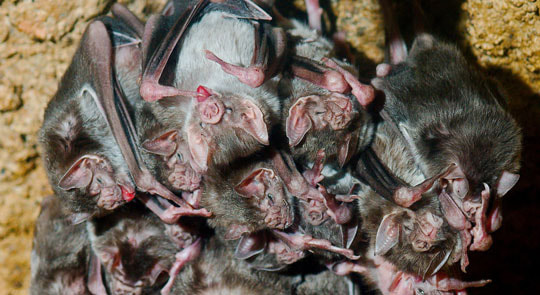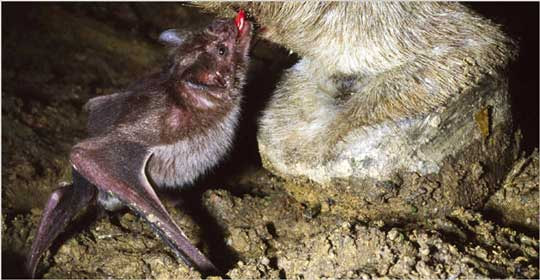|
Sometimes I feel compelled to bring justice to certain animals that have an unfairly nasty reputation. Snakes, for example, do not deserve to be almost universally hated. Mice are another example... what could be more harmless than a mouse? Chiggers on the other hand... well, don't get me started on those evil demons from hell. What do you think of when you hear the name Vampire Bat? I'm guessing that the thoughts going through your head are not exactly pleasant. So, my duty today is to inspire a bit more respect and admiration for this creature. What the heck is a Vampire Bat? First of all, not all bats are vampire bats. In fact, of the 1,300 or so species of bats in the world, only THREE of those species are vampire bats. All bats are in the order Chiroptera, and the three species of vampire bats happen to be in the family, Phyllostomidae, also called the leaf-nosed bats. The three species include the common vampire bat, the hairy-legged vampire bat, and the white-winged vampire bat. Vampire bats can be found from Mexico south into South America. What makes vampire bats so unique among bats is their feeding habits. They have evolved to consume blood, a habit called hematophagy. That's all they eat—blood. No insects, no fruit, no nectar, not even asiago cheese bagels. They don't even drink water. Just blood. This habit, of course, is the source of all the unwarranted human derision of these animals. Amazing facts about Vampire Bats These bats were named after vampires, not the other way around. Since vampire bats live only in the New World, they were not described in scientific literature until 1810. As you probably know, myths about blood-sucking humans called vampires existed long before that. And then, in 1897, Bram Stoker's Dracula was released, and thus was born the silly idea that vampires could shape-shift into the form of a bat. As you can imagine, the vampire bat's reputation went downhill from there. By the way, Stoker also allowed Count Dracula to shape-shift into mist and into a wolf. Even the medical community has embraced the pop culture association of bats and vampires! A Venezuelan research team isolated a new anticoagulant from one of the vampire bat species. They named the substance "Draculin." Vampire bats are small, averaging only 3.5 inches (8.9 cm) in body length and two ounces (56 g) in weight, although that weight can double during a good feeding. I mention this because people often assume they are much larger. In fact, Bram Stoker himself wrote the following quote in Dracula: "I have not seen anything pulled down so quick since I was on the Pampas and had a mare ... One of those big bats that they call 'vampires' had got at her during the night and ... there wasn't enough blood in her to let her stand up." Hmm... perhaps Stoker didn't realize vampire bats only weigh two ounces. Vampire bats very rarely attack humans. That's not to say that they are picky eaters—they will feed on the blood of just about any animal. Mostly they feed on birds and farm animals, but they have been known to feed on porcupines, armadillos, snakes, sea lions, and even penguins. Notice the tiny size of these white-winged vampire bats feeding on a sleeping chicken: Let's take a closer look at vampire bats' feeding habits. First of all, these bats do not suck blood. Instead, they make a small skin puncture with their needle-sharp teeth, and then they use their tongue to lap up blood that comes from the puncture. They can consume about one ounce (30 ml) in one night, and it usually takes them about thirty minutes to lap up this much blood. As you can probably guess, they only feed at night. Now this is interesting... If vampire bats go more than 48 hours without a meal, they die. When a vampire bat has a hard time finding enough food during the night, it will fly back to the roost (sometimes a roost may have hundreds of bats). There, the other bats that were more successful will regurgitate their extra blood so that the hungry bats can get enough to eat. Wow! See how friendly vampire bats can be? These creatures have their own social safety net. This odd social behavior gets even more amazing. Research has shown that vampire bats will only regurgitate blood for other bats that are either close family or friends. The close family part of that statement is not surprising. It's the friends part that I find most fascinating. As it turns out, while vampire bats are hanging out (literally) in the roost during the day, they make friends. How do they make friends? For a bat to make a friend, it must take the time to groom and socialize with another bat (socializing basically involves snuggling up together). And it takes one to two months of grooming and snuggling before a bat is considered a friend. Check out this video of vampire bats making friends So, bats that do not invest the time and effort to make friends are at risk of starving whenever they have a bad night hunting for blood. See what I mean? Vampires bats have to be friendly! (I wonder if there is a lesson we can learn from this...?) Let's look at how they actually hunt and feed. These bats have infrared perception in their snouts. These heat-seeking sensors help them find warm-blooded animals and then help them find veins that are near the skin's surface (kind of like my sensors that zero in on a good taco bar). Also, like other bats, vampire bats use echolocation (seeing with sound), allowing them to find their way around in the dark. Bats are the only mammals that can fly (gliding doesn't count). While most bats cannot walk, vampire bats are the only mammals that have ancestors that evolved flight, then lost the ability to walk, and then re-evolved the ability to walk. Yep, these little guys can scoot along at three feet (1 m) per second. That's pretty useful for an animal that needs to land and then sneak up on a larger animal to steal some blood. Check out the bat's walking mechanics below. Okay, so the bat lands near its source of food, such as a sleeping cow, then it walks over to the cow and locates a vein near the surface. The bat uses its unbelievably sharp incisor teeth (these teeth do not have enamel, so they remain permanently razor sharp) to puncture the skin. So that the cow's blood does not clot up and stop flowing, the bat's saliva contains anticoagulants (yep, one of those anticoagulants is the one called Draculin). Usually, the sleeping animal doesn't even know its blood has been stolen. Finally (and this part is really cool), vampire bats have their favorite restaurants. Let's face it, a 2-ounce bat feeding on a massive pig or cow is risking its life for a meal. The larger animal could step on the bat, roll over on it, or even slap it with a wing, hoof, or tail, smashing it instantly. So, when a bat finds an animal that is particularly easy to feed on (a nice fat vein near the surface, an animal that sleeps soundly, etc.), then the bat will return to that same animal night after night. How do they find the same animal? Vampire bats can locate their prey by sensing the sound of an animal breathing. In fact, this is so sensitive that they can even recognize the breathing pattern of one specific animal, allowing them to return to that particular buffet night after night. The vampire bat below is feeding on a donkey's hoof. Again, vampire bats rarely feed on humans (humans happen to have hands for swatting, which we can do even when we are asleep, so we are kind of dangerous to these bats). They aren't picky, however, so if you sleep in the open air (without a tent) where vampire bats live, your arms and legs are fair game. So, the Vampire Bat deserves a place in the L.A.H.O.F. (Lulu Animal Hall of Fame). FUN FACT: The word lulu originated in 1886. It refers to any remarkable or outstanding person or thing ("I read my first Bridgers book the other day, and it was a lulu."). This word is thought to have originated as a reference to Lulu Hurst. Who is Lulu Hurst? She was also called the "Georgia Wonder." She was a popular attraction from 1883 to 1885. Supposedly, she possessed a mysterious force that "allowed her to effortlessly move, with just a light touch, umbrellas and canes held tight by others." She was only 15 when she became famous for this act. So, lulu is another way to say awesome! Photo Credits:
Icy leaves - Stan C. Smith Snow flake - Wikipedia Electron microscope image - Wikipedia Terminator - James Bareham/Polygon Vampire bat #1 - Uwe Schmidt - Wikimedia Commons White-winged vampire bats feeding on chicken - Bat Conservation International/J. Scott Altenbach Vampire bats roosting - Josh More/Flickr Walking vampire bat - Daniel K. Riskin, John W. Hermanson Vampire bat feeding on donkey's hoof - Adrian Warren via The New York Times
0 Comments
Leave a Reply. |
Stan's Cogitations
Everyone needs a creative outlet. That's why I write. Archives
July 2024
|






 RSS Feed
RSS Feed